Automating the sound. Ars combinatoria and mystical automata
The description of reality composed of groups of discrete or continuous data offered by the modern theory of information is in fact nothing but yet another attempt to systematically capture the elementary dichotomy of order and chaos ? a dichotomy also visible in art. In the course of centuries, theoreticians and philosophers tried to situate music in the harmonically constructed world intended to reflect God?s plan, and doing it, they not rarely referred in their elaborations to the queen of the sciences ? mathematics.
For centuries, formalised mathematical operations on discrete data (numbers and characters) have helped solve basic problems related to music, e.g. establish musical temperament (Pythagorean monochord), shape musical nomenclature (solmisation by Guido of Arezzo), define musical forms and principles of their creation (round, canon, isorhythm, mensural notation). Before the arrival of the information era, the process of making ?computational music? 1?? music using calculations on numbers and characters for artistic purposes ? frequently excluded direct involvement of an author. It was generated by means of combinatory tools 2?and automata, i.e. mechanical or electro-mechanical ?instruments? ? their self-playing functionalities liable to programming evoked both fear and fascination. Such devices provoke a legitimate question about the essence of what a musical instrument is and how its functioning, supported by specific mathematical principles, affects the course of artistic creation and the role of a man as its initiator. Finally, they evoke questions about the relation between music and not only mathematics itself, but also theatre, magic and religion, pointing to the crucial social context of practices related with art and the reflection on art over the centuries.
Sicut superius sic inferius ? ?as above, so below? ? is a maxim dating back to the 1st-century Greek-Egyptian hermetism. Its representatives in the Middle Ages and the Renaissance, similarly to later speculative musicians-philosophers (Johannes Kepler or Robert Fludd), perceived ?the universe in musical categories, and music in cosmic categories? 3. The universal harmony of the spheres which, also according to Pythagoreans, cemented macro- and microcosm with the help of a system of numerical proportions, may be understood as a type of an internal mathematical-symbolic code undergoing combinatory procedures 4. The conviction about the natural interconnection between all living creatures, nature and celestial bodies was manifested in numerously developed models of the world consisting of a strictly defined number of concentric circles or spheres until early stages of the 17th-century Cartesian rationalism. This idea has its origins in the viewpoint typical of archaic cultures which also provide early examples of applying combinatorics, such as in a simple tic-tac-toe game.
At the beginning, ars combinatoria was linked with poetic prosody, mnemotechnics and religious practices, especially prophecies and prayer, rather than with music itself. Its first examples can be found in Far Eastern culture: China, India and Tibet. In Chinese cosmology (Tao), an overwhelming, unifying principle ? The Tao produced One; One produced Two; Two produced Three; Three produced All things 5?? gives rise to two elementary forces: yin and yang. They are constantly transformed by turning into their own oppositions which has its equivalent in mathematics called Markov process (probability ?) 6. In the ?I Ching?, the Confucian ?Book of Changes? (the 1st century AD and before), yin and yang are presented in the form of broken and solid lines and their permutations give 26 = 64 possible results, i.e. hexagrams-prophecies obtained by means of drawing coins or twigs. Different from the original one, the logical combination of all 64 hexametres performed by Shao Yung ca. AD 1060 led subsequent mathematicians to the incorrect conclusion that the ancient Chinese already used the binary system in which e.g. the binary sequence 000000 would be equivalent to 6 broken lines in the hexagram k?n (?Field?), whereas 000001 ? to 5 broken and 1 solid line. Essentially, this conviction was untrue but it became an important inspiration for Gottfried Wilhelm Leibniz and his logic. Fortune telling with the help of stalks, stones and shells was not the only ancient method of obtaining full knowledge about the world and upcoming events that was based on combinatorics and probability relations. The mythical Greek prophetess Sybil was believed to write words of her prophecies on leaves which she then scattered while standing at the threshold of her cavern. After collecting them again, the resulting sequence of words formed a prophecy.

GEORG PHILIPP HARSD?RFFER, ?F?NFFACHER DENCKRING DER TEUTSCHEN SPRACHE?, 1651.
Most probably, the tradition of Greek and Roman permutation poetry drew from the ancient Persian rhetoric and what was considered particularly valuable was the ability to create multiple statements on the basis of the limited spectrum of means (copia). The simplest form of the classical poetic formalism was chiasmus ? a figure of speech (Greek ???????, chiasmos ? to shape like the letter ???) involving two clauses parallel to each other, the second being the reversal of the first one, while maintaining the syntactic order in both sub-parts, e.g. in ?Stichus? by Plautus: Ego tu sum, tu es ego, ?I am you, you are me?. The more advanced form of chiasmus was a permutation poem ? for instance, a 20-stanza-long variation on a single stanza in Optatianus Porfirius? ?Carmen XXV? ? and finally, the Protean poem in which chosen words were exchanged with each other and shifted to further lines without violating the rules of grammar.
It was a type of ornate-style poetry which was ? next to acronym or abecedarius ? particularly popular in the Baroque. In a literary work, it followed the unusually complicated construction principle as far as the arrangement of sounds and rhymes is concerned. Derivative is ? based on permutations ? Baroque visual poetry called carmen infinitum characterised by words forming a circle. Its founders (e.g. Georg Philipp Harsd?rffer, author of a words generator from 1650 or Quirinus Kuhlmann, accused of heresy, whose ?14th Kiss of Love: On the Permutation of Human Matters? from 1671 includes a total of 13!12= 3 . 399 * 10117 permutations) drew from the creative output of two pioneers of musical combinatorics in medieval and Renaissance Europe ? Ramon Llull and Athanasius Kircher.
In his ?Ars Magna? published in 1305, Ramon Llull, a mystic from Mallorca, described his method of obtaining complete knowledge about reality using a mechanical-logical machine composed of independently rotating concentrically arranged A and T discs. Letters (from B to K) written on each of them referred to 9 God?s attributes, logical relations and questions, subject matters (e.g. a man or an angel) as well as virtues and sins. Such a simple, semantic database, ars raimundi alphabet, constituted the foundation for combinatory operations: a list of all possible two-letter combinations (altogether 8+7+6+5+4+3+2+1=36 pairs) obtained as a result of the discs? rotation is presented in an additional table, whereas possible three-letter combinations (28*9=252) are depicted in so called Tabula Generalis 7.
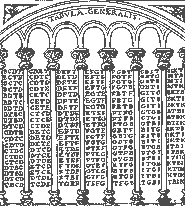
RAMON LLULL, TABULA GENERALIS, ?ARS MAGNA?/?ARS GENERALIS ULTIMA?, 1305.
Significantly, all repetitions and statements considered in advance as untrue were rejected a priori. Therefore, it would be hard to call Llull?s formal-mechanical system of generating logical statements a programming language because, firstly, it operates on lists of data and not algorithms, secondly, it uses their combinations (instead of permutations) in order to eliminate logically false results. And, although this didn?t rule out the possibility of benefiting from so called Lullian Circle ? probably patterned on the Arabic device zairja ? for artistic purposes, counting machines designed by Athanasius Kircher turned out to be much more useful in this field.
Kircher, the author of 1669 “Ars Magna Sciendi, Sive Combinatoria”, revises Llull?s method in the third chapter of his work by secularising it through replacing rich (often pointing to the Holy Trinity and angels) definitions from the combinatory alphabet with more formalised, short symbols or even pictograms forming a sort of a proto-interface. On the other hand, in his “Musurgia Universalis” (1650) Kircher writes, “Mechanical music creation is nothing but a certain strictly defined method which I invented to let anybody, even without any musical knowledge, compose melodies using instruments which produce music” 8. In the eighth chapter of his work, the scholar presents in detail his Musurgia Mirifica ? a method of composing vocal pieces based on combinatory assignment of selected melodic lines, rhythmical structures and poetic text?s metre (Musarithmi) to four choir voices.
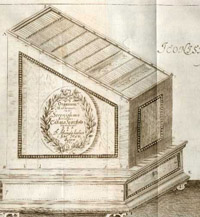
ATHANASIUS KIRCHER, ORGANUM MATHEMATICUM, ?MUSURGIA UNIVERSALIS?, VOL. 2, 1650.
The resulting interdependencies are depicted in tables (Musarithmi melothesias; Pinacis). Taking from Llull?s earlier works and Marin Mersenne?s writings, Kircher further demonstrates a model of a musical counting machine functioning on the basis of an algorithm written by himself ? a type of abacus (Abacus Melotheticus) which enabled composing music without a competent author?s involvement. Arca Musarithmica is a wooden box containing a set of slats with data written on them in rows, corresponding to notes in a music scale and their duration which should be used to create a desired musical phrase. Tables are grouped into categories representing scales and modes, counterpoints (simple or floridus); they also contain instructions for a recommended type of voice (soprano, alto, tenor, bass), register and method of working on the poetic text. Additional short lists depict how numbers are assigned to particular tones. The task of an unqualified “composer” who prepares a piece with the help of Arca Musarithmica is solely to choose a slat from a given category and use the data of the tables. On the other hand, Organum Mathematicum described by Kircher?s assistant Gaspar Schott, is a device close in its functioning to Arca Musarithmica. The only additional feature is the extended range of used data also containing information from such disciplines as arithmetic, geometry, astrology and calendar, which results in generating a specific combinatory “knowledge compendium”.

ATHANASIUS KIRCHER, ARCA MUSARHITMICA, ?MUSURGIA UNIVERSALIS?, VOL. 2, 1650.
*
A type of a mechanical device serving as a tool for creating art understood this way are automated instruments and the earliest among them: ?natural? automata 10?in which the sound is generated by the unprompted wind or the water flow affecting the mechanism composed of e.g. strings or pipes. Archaic Aeolian instruments such as flute-kites or wind harps (later designed by Kircher as well) are one of the earliest inventions of this kind, not counting the mythical figure of Memnon in Thebes producing characteristic whistles and crackles under the influence of beams of the rising sun or the automated Salomon?s throne. The ?miraculous? throne? was supposed to be surrounded by moving and sound-making figures of animals (lion, eagle, cock, cat) and apparently it gave off a smell of exotic perfume.
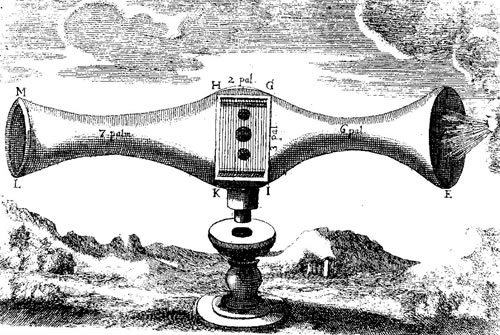
ATHANASIUS KIRCHER, ARPA EOLICA, ?PHONURGIA NOVA?, 1673.
Together with development of pneumatics in the early 1st century AD, Hellenistic mathematicians and engineers: Ctesibius of Alexandria (285-222 BC), Philo of Byzantium (ca. 280-220 AD) and Hero of Alexandria (10-70 AD) triggered production of mechanical instruments propelled by water with compressed air pumped into them ? the air, after being extracted into so called camera aeolis, produced sounds in pipes: water organ (hydraulis) and water flutes (cornucopia). They were, however, not entirely self-contained ? the water pump was often handled manually, while a keyboard linked with a system of valves helped air get through to chosen pipes. After pressing an appropriate key, a desired sound was made. Water clocks were almost immediately complemented with sound-making devices such as mechanical birds or bells (Apollonius of Perga, Ctesibius) or gongs and drums (Vitruvius) aimed at more attractive and catchy signalling of the passing hours. The water clock in which stable water flow ensured continuity of measuring time is also a device considered to be a primogenitor of the feedback controller 11.
The first real pneumatic automata were inventions of three Ban? M?s? brothers, Persian scholars living in Bagdad around the 8th-9th century, who designed around 100 machines described in ?The Book of Ingenious Devices? (Kitab al-Hiyal, 850). In their devices, water flow was controlled by means of several valves and pressure cranks also used in the construction of music instruments: automated steam flute or fully mechanised water organ. Musical automata by Ban? M?s? brothers and their continuator Al-Jazari are the first known programmable sequencers using self-functioning controllers to create music. Al-Jazari, the Arabic scholar living in the 12th century, called a forefather of modern engineering also made a model of a floating band of robot musicians with a rich repertoire of melodies, rhythms and gestures. Water was sucked in by a pressure pump and shifted up where a camshaft with cams, whose movement was triggered by the water weight, changed the revolving movement into two-directional placement of a horizontal rod pressing levers located under given instruments of automated musicians. Inventing a camshaft, as described in the famous in Europe and numerously copied ?The Book of Knowledge of Ingenious Mechanical Devices? (?al-J?mi? bain al-?ilm wa al-?amal al-n?fi? f? ?in??at al-?iyal?) written by Al-Jazari, opens a new chapter in the development of automation having significant consequences for the evolution of music culture in Europe.
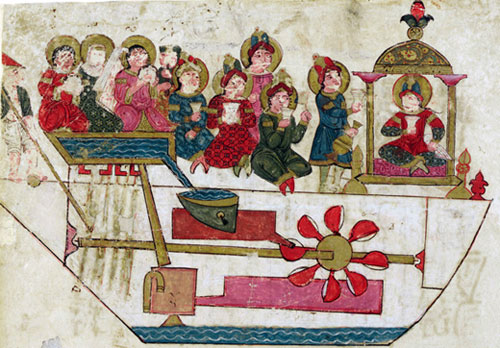
AL-JAZAR?/FARRUKH IBN ABD AL-LATIF, ?KIT?B F? MA?RIFAT AL-HIYAL AL-HANDASIYYA?, 1206/1315.
The camshaft enabled the replacement of rotating motion with a two-way movement which made it the basic tool of programming automated music machines from the late Middle Ages to the 19th century. In this period, automatophones were mechanised versions of traditional instruments in which pipes, strings, bells or metal plates stimulated by the system of levers linked with the revolving cylinder were the source of sound. The energy necessary to put the mechanism into motion could be supplied by turning the crank or spring, or by pumping bellows, while a wooden box guaranteed augmenting the sound.
Following the history of musical combinatorics and automation, what is worth noticing is the technological progress and its consequences for the social practice of composers and performers. The self-playing figure of the ancient colossus Memnon, Hero?s magic machines built in temples and theatres or outstandingly complicated pneumatic devices by Ban? M?s? brothers and Al-Jazari caused awe and gave an average man the impression of dealing with supernatural power whose autonomy was only understandable to the chosen: scholars and clergymen. Monarchs, aristocrats and priests had access to secret knowledge enclosed in sacred books, practiced alchemy and occultism or exchanged costly souvenirs such as lavishly decorated clocks with musical boxes 12. A simple example of applying combinatorics by representatives of higher classes of the European society were popular games depending on random number generators (for instance, the dice) such as hazard or ?craps” 13. Their gradual popularisation lead to developing a new form of entertainment in the 18th century: a combinatory composing method dedicated to amateurs, so called Musikalisches W?rfelspiel. According to it, a musical work was created by throwing the dice ? each of the results was assigned to specific pre-compositional material. The earliest examples of this method are music games devised by Johann Philipp Kirnberger, Carl Philipp Emanuel Bach, but also by Haydn and Mozart. In ?”Musikalisches W?rfelspiel” ? the game published in 1792 and attributed to Mozart ? a figure being a sum of pips obtained by two rolls of the dice was to be found in a vertical column in one of two tables, while in a horizontal column of the same table, the measure number was written down in Roman numerals from 1 to 8. The resultant of the two figures pointed to one of 176 fragments of music serving as material to create in total 1116 = 45,949,729,863,572,161 minuets ? each composed of 16 measures (two tables of 8 measures). Undoubtedly, William Hayes? description of a method helping amateurs and averagely talented people compose aleatoric music, being in fact a satirical pamphlet on the solemn artistic output of Handel, is also worth mentioning. The method involved making ink dots on a piece of paper with a printer?s brush and freely complementing them with tails and other signs so that eventually, a notation of a musical piece is prepared. Even if it is nothing more than a fantasy of the 18th-century author…

WOLFGANG AMADEUSZ MOZART, ?MUSIKALISCHES W?RFELSPIEL?, TABELE, 1792.
Together with the increased usage of the camshaft (starting from the 13th century), automated musical instruments were often installed as chimes in church towers and in the 15th century, also in the form of bells connected with mechanical clocks in town hall?s towers. They were particularly popular in Belgium and the Netherlands, whereas in England, a special combinatory method of playing bells was developed: it involved permutations and algorithms for creation of tone series to appear in a different order each time (change ringing, the 17th century). This simple rule of unrepeatable sequences played using the same number of bells made it possible to avoid playing recognizable melodies which in turn enabled maintaining exclusively informative and impersonal character of sound signals directed to the entire community. This principle stemmed from a strictly mathematical algorithm ? determining subsequent shifts in change ringing ? which was easy to be remembered and transferred onto a score not only by professional musicians but, what is important, by amateurs who actually used this method.

Carillon’s mechanics.
Finally, introducing a coil spring to the watches? construction by Swiss watchmakers initiated the serial production of musical boxes (the first factory was opened in 1815 14). Miniature organ (hurdy-gurdy, organette, serinette), string (virginal, spinet), flute (flute clock) automatophones or orchestrions and nickeldeons imitating the sound of a group of instruments? (e.g. M?lzel?s panharmonicon) produced sounds which representatives of all, also lower, social groups gradually got used to in their daily life (in churches, in the streets). Their construction reached a high level of technical complexity (a good example would be Samuel Bidermann?s instruments) and in the early 19th century, melodies played by automatophones constituted more than a half of all music sounds an average European ever came across 15.

Bidemann’s musical clock with spinet and organ
This amount increased even more when a piece of perforated paper accelerated the launch of the piano player around 1860, then the player piano whose self-appointed father was an American, John McTammany. In the United States from before the Great Depression, 70% among around 350 000 pianos produced annually were player pianos 16. This is how the ultimate democratisation of musical automata took place. Devices found their way to almost everyone?s house allowing people to make music at home, regardless of their musical knowledge and social status.
Nevertheless, even in the early 20th century, self-moving and sound-making machines still seemed mysterious and extraordinary to an average person. In their article from 1957, Lejaren Hiller and Leonard M. Isaacson quote research according to which fear of automation is still among the head phobias experienced by the statistical American 17. In the ancient times and the Middle Ages, ?self-acting? devices were often associated with supernatural interference. Yet, what is interesting, Arabic constructors who prepared descriptions of even the most complex steam- or water-propelled instruments always added a conditional formula: ?if God allows?. They seemed to worship fitfulness of water flows in pneumatic machines, underlining their dependence on God?s will that one should be submissive to 18. As Minsoo Kang writes, ?In the Middle Ages and the Renaissance, even as people were captivated by the automation image, they felt uneasy in the face of its luminal nature (animate/inanimate?; natural/supernatural?; living/dead?). They articulated that uneasiness in the language of magic, through which they worried over whether the self-moving object was the work of legitimate or diabolic art. Once the mechanistic philosophers of the seventeenth century reasoned away its magical aura, they adopted the automaton as an essential concept in their intellectual works, completely assimilating it into their worldview 19?.?Rationalisation of automata in the 18th century gradually contributed to development of a stereotype defining automated devices as ?not having the soul? and analogically, a certain metaphorical overview of the society as a centralised mechanism governed by a superior individual whose authority (coming from God?) could assume various forms of tyranny.
Time frames for the highest popularity of automata in the Enlightenment were marked by (also musical) inventions by Salomon de Causa and Jacques de Vaucauson at the start of the period and Pierre Jaquet-Droz and Wolfgang von Kempelen in its closing. The concept of automaton as a self-moving and sound-making magic machine was re-born in Romanticism together with works of researchers and pioneers of electromagnetism or ?techno-spiritists?: Samuel Morse, Franz Mesmer and Thomas A. Watson to whom the development of electricity? ? beginning with the mid-13th century ? became a new breeding ground for imagination and the panacea to the deepening ?Cartesian? conflict between enthusiasts of the mechanistic and the vitalistic vision of the world. As Erik Davis writes, ?Though sound and music are essentially incorporeal aspects of human experience, they are dependent on the latent potentials of matter: bamboo tubes, stretched animal skin, throat-flesh. Even more fundamentally, sound rests upon vibration, the analogue fluctuations of that vaporous fluid we call air. But in the late 19th and early 20th century, that ocean of vibration became electrified 20”.?The musical potential of electromagnetism ? ?ethereal fire? being the subliminal binder of matter and spirit ? had already been noticed by Kircher who had pointed to chosen sounds as ?magnetic?, and even Beethoven used to say enigmatically, ?I am electrical by nature. Music is the electric soil in which the spirit lives, thinks and invents 21”.
The first known electrophone supplied by electric power ? the much more stable source of energy than water or human muscles ? emerged in Europe simultaneously with the invention of a lightning-conductor in the mid-13th century. Its inventor, a Czech clergyman Prokop Divi?, intrigued by the electrocution-related news from Saint Petersburg, designed Denis D?Or (ca. 1753), an ancestor of the later clavecin ?lectrique by Jean-Baptiste Delaborde and Thaddeus Cahill?s telharmonium. The ?golden Dionysus? was equipped with a keyboard of 14 double registers and a pedal. The complicated system of the astonishing number of 790 interconnected metal strings charged with electricity enabled not only generation of good quality tones but also imitation of the sounds made by other chordophones or even wind instruments. Supposedly, the potential attraction of this primitive electromechanical synthesiser ? a sound-generating appliance equipped with a keyboard ? was also a possibility to give a light electric shock to players if their performance was not appreciated by the device?s constructor.
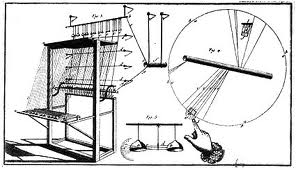
JEAN-BAPTISTE THILLAIE DELABORDE, ?LE CLAVESSIN ?LECTRIQUE: AVEC UNE NOUVELLE TH?ORIE DU M?CHANISME ET DES PH?NOM?NES DE L??LECTRICITɔ, 1761.
Buzzing of electrical cables, since then continuously present in people?s daily life, was found fascinating, at least since the 19th century: in 1899, Williamm Duddell presented in London his keyboard instrument using alternating current power in gas street lamps (singing arc lamp). Earlier ? in 1874 ? Elisha Gray demonstrated his musical telegraph in a Presbyterian church in Illinois. Its single tunes were generated by a simple, self-vibrating oscillator. After pressing a key, an impulse of a certain frequency was sent through the cable which, by resonating metal bars, generated sounds. A telegraph, telephone and finally, phonograph were amazing electro-acoustic inventions of the late 19th century which re-connected technology with magic, becoming a mysterious medium being able to translate electromagnetic pulsations to clatters, crackles and voices in a telephone receiver. Just like in Allan Kardec?s s?ances, people tried to hear whispers of the dead or hidden messages from extraterrestrial civilisations, creating their own sonic fictions 22.
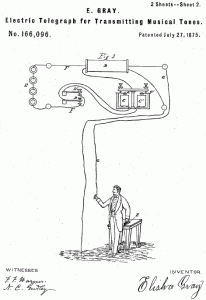
ELISHA GRAY, ?ELECTRIC TELEGRAPH FOR TRANSMITTING MUSICAL TONES?, 1875.
Before the 20th century, techgnostics were unceasingly interested in a human being whose appearance, movements and voice were imitated by automata constructed by Hero of Alexandria (a figure of a woman pouring wine), Juanelo Turriano (a lute player, a praying monk 23), Leonardo da Vinci (a moving figure of a knight) or Friedrich von Knauss (a writer). Heretic ?talking heads? apparently capable of answering any questions are present in the Nordic mythology (M?mir?s head) or Greek mythology (a singing head of Orpheus); in the Middle Ages, they are believed to have been constructed, among others, by Roger Bacon and Gerbert d?Aurillac.
In the 17th century, Athanasius Kircher designed ?talking statues? which, owing to the use of a resonating tube hidden in the walls of the building, would carry sounds from a given room and place them in the mouth of a ?taking statue? causing consternation and astonishment among its viewers.
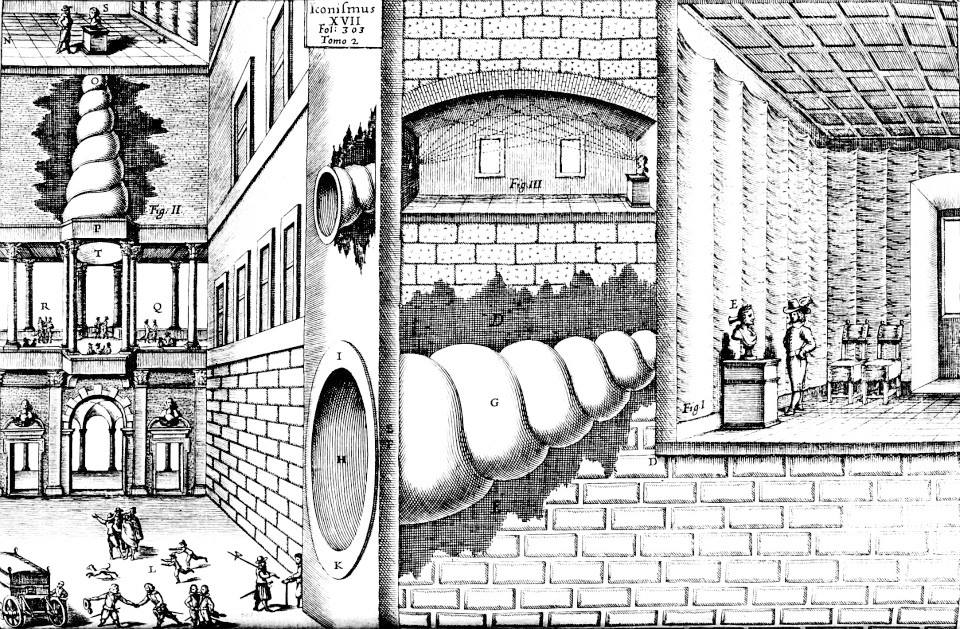
ATHANASIUS KIRCHER, A Talking Statue, ?PHONURGIA NOVA?, 1673.
Eventually, in the Enlightenment era, the development of the first scientifically described proto-synthesisers of speech ? mechanical machines imitating the sound of the human voice ? is intensified: in 1779, the Russian Academy of Sciences in Petersburg announced a contest for construction of a head which would be able to say 5 basic vowels /a/,/e/,/i/,/o/,/u/. Friedrich von Knauss? musical automata were not successful in it ? in contrary to the Russian scientist, Christian Kratzenstein?s device composed of resonators with vibrating reeds by which it resembled a human articulation apparatus.
Earlier ? back in 1769 ? Wolfgang von Kempelen started experimenting with a speaking automaton. In his recapitulative work published in 1791, he gives an account of the results of his research on European languages? phonetics and describes his ?sprechende Maschine? (a talking machine). It enabled articulation of not only vowels but also 19 consonants owing to manual manipulation with channels, through which the air was pumped with bellows, and with a leather resonator serving as the ?artificial mouth?.

WOLFGANG VON KEMPELEN, talking machines, ?MECHANISMUS DER MENSCHLICHEN SPRACHE NEBST BESCHREIBUNG EINER SPRECHENDEN MASCHINE?, 1791.
The improved version of this early mechanical speech synthesiser was demonstrated in 1837 by the pioneer of telegraphy, Charles Wheatstone, whereas in 1845, Joseph Faber presented Euphonia ? an astounding machine equipped with an artificial tongue, uttering (and singing!) long sentences in several European languages with a voice described as monotonous and coming as if from beyond the grave. An unusual version of God Save the Queen performed by Euphonia could be heard in London in 1846. Its constructor, not being instantly appreciated for his work, destroyed the machine which had become an object of jokes and compared by many people to Frankenstein, then committed suicide. His invention, however, came in time to inspire a Scottish professor of physiological phonetics, Alexander Melville Bell and his son Alexander Graham Bell.

JOSEPH FABER, EUPHONIA, 1846.
Inventions imitating physiological processes of living organisms, which Kempelen, Vaucauson or Faber came up with, question the boundary between a human and a machine, paving the way for development of modern robotics ? not so much humanoid marionettes (man machines, human dolls) as people-automats (machine-man, android). The term ?android? (from Greek: andros = ?man?, eides = ?having the form or likeness of?) was used for the first time already in 1728 in ?Cyclopaedia? published by Ephraim Chambers in London. The author applied this term to a work by Albertus Magnus , a 13th century German catholic bishop, scholar and alchemist who, allegedly, managed to create a living being resembling a man 24. In order to do that, he acquired the necessary knowledge from Arabic and Jewish sources, including ?Sefer Yetzirah? (?Book of Formation?). This early text on Practical Kabbalah contains the description of the world?s creation by means of combinatory operations on 22 letters of the Hebrew alphabet ? with numbers attributed to each of them. They are arranged in the shape of a circle and amount to a total of 231 possible combinations; creating them was to give the beginning to all possible subsequent beings.

ALBERTUS MAGNUS, JOOS VAN GENT, OK.1475.
The Jewish mystical theurgy directs attention to the performative aspect of multiple operations on letters and numbers as well as their creative potential. Endless, meditative-prayerful reciting of Tetragrammaton was supposed to bring to life a spiritual being which, after joining the matter, created a golem, i.e. already mentioned in the Bible clay humanoid automaton deprived of the soul. It was ?activated? by obtaining a name, e.g. Adam (?the first man?), while the change of letters of that name, for example transforming ?adam? into ?dam? (?blood?) put it to death. Supposedly, Albert Magnus and, later, the Maharal of Prague and Paracelsus also worked on creating a golem. In Romanticism, the common imagination was again caught by fascination with a mythical doppelg?nger, a supernatural double who was apparently called out by Luigi Russolo himself in his occultist experiments (as testified in the ? quoted by Luciano Chessa ? fragment of the third-person diary written by Maria Zanovello, the composer?s widow) 25.
What links ancient Tibetan prayer wheels and the Lullian Circle? Or turning tables of the 19th-century spiritists and the 20th-century DJs? Or the Aeolian harp and SuperCollider? ?A talking head? and VOCODER? Where do the sounds of mystical automata come from and do robots have souls? As noticed by Florian Cramer, both magical practices and the use of a counting machine such as computer has a clearly formal-technological foundation characterised by symbolic manipulation and significant creative potential 26. According to the mystical beliefs of the Middle Ages, preparing a huge number of combinations involving numbers and letters was once a method of creating the entire real world and beings which exist within it. In subsequent centuries, combinatory counting machines gave people the feeling of being in control of the whole knowledge accessible to them. Together with further discoveries in the field of mechanics, telegraphy and electricity, amazing combinatory machines challenged the boundary between the animate and the inanimate, the human and the divine and evoked besetting questions which usually remained unanswered. The relation between ?mystical? automata and transformations happening in parallel in the sphere of beliefs: religion, magic and theatre is specifically visible in music ? in evolving methods of its creation and changing music-related social practices. According to Florian Cramer, it is music that is the oldest and formally the most advanced art based on computation. Mathematical sound modelling ? to begin with Pythagoras, through Sch?nberg and later ? results in a code consisting of figures-symbols which then undergoes multiple recalculations. In the broader philosophical context, the code is sometimes interpreted as a key to the mystery of the world, both nature and culture, and using it resembles mystical and occultist practices aiming at bringing to life new beings and achieving cognitive transgression.
Pre-computational music which emerged thanks to mechanical or electro-mechanical instruments operating with numbers and letters and ruling out direct participation of a competent creator, anticipated the 20th-century serialism, aleatoric, algorithmic and computer compositions. Above all, however, it is an attempt of people ? ?incompetent? and aware of their limitations ? to go beyond the means and methods available to them in order to access the unknown but the already sensed and to try to achieve artistic effects similar to the real creation by the divine demiurge. The history of computational music reaches wider circles, when in the 19th-century common imagination, the mythical golem is replaced by the female android after the once very popular ? and today slightly forgotten ? novel by Adam Villiers ?L?Eve Future? from 1886. Its main character, Halady, is an attractive and intelligent electric lady who owes her beautiful voice not to mechanical proto-synthesisers of speech but two modern golden phonographs installed in her lungs! Each of them is built from a stylus reading grooves on the foil wrapped around a rotating cylinder and making a membrane vibrate which makes it the source of sound. In Villiers? novel, the constructor himself ? nomen omen called Edison ? characterises his female android in the following way, ?Here are two golden phonographs inclined endways towards the chest which serve as Halady?s lungs. They transmit to each other sheets of her harmonious ? or should we say heavenly ? conversations like printing presses pass on sheets for copying. One tin band can contain seven hours of her speech. Her words are thought up by the greatest poets, the most subtle metaphysicians and the deepest writers of our times? 27.
From here, it seems that there is only one step left to Erik Davis? whirling bright sonic beings which will traverse space and time, reading hidden codes of the harmony of the spheres and melting in the vibrations of the technological sublime…
?Barbara Bogunia
Latin:?computo, computare?? to calculate or estimate. ↩
Combinatorics ? the branch of discrete mathematics studying the enumeration, combination, and permutation of sets of elements and the mathematical relations that characterize their properties,??Combinatorics?, from?MathWorld-A Wolfram Web Resource?[online:] mathworld.wolfram.com/Combinatorics.html. ↩
Joscelyn Godwin,?The Revival of Speculative Music,?Musical Quarterly, LXVIII (3), 1982, pp. 373-389. ↩
Florian Cramer,?Words Made Flesh,?Piet Zwart Institute, Rotterdam, 2005, p. 25. ↩
Tao Te Ching?attributed to Laozie (around the 6th century B.C), chapter 42, translation J. Legge (1891). ↩
Markov process ? a stochastic process resulting in creating a sequence of events where future probabilities are determined by its most recent values, Wiesstein E.W., ?Markov Process.?,?MathWorld-A Wolfram Web Resource, [online:]?mathworld.wolfram.com/MarkovProcess.html. ↩
The description of Llull?s counting procedures sometimes lacks precision. I based my research, among others, on Florian Cramer?s findings, ibid. pp. 36-41. ↩
Athanasius Kircher,?Musurgia Universalis, sive ars magna consoni et dissoni, Rome 1650, Vol. 2, p. 185. ↩
The prototype of Arca Musarithmica from around 1668 constructed by Samuel Pepys can be seen in The Pepys Library at the Magdalene College, Cambridge. The prototype of Organum Mathematicum was built by Schott in 1661, two copies of the device are in the collections of museums in Florence and Munich. ↩
From Greek ????????? = self-moving, self-propelled, a term describing mechanical, self-functioning machines ? including musical ones ? created since the ancient times, particularly popular in Europe since the 1730s and later (1848-1914, so called ?The Golden Age of Automata?). ↩
This opinion was expressed, among others, by Otto Mayr,?The Origins of Feedback Controller,?The MIT Press, Cambridge, 1975. ↩
One example could be a clock with bells, hurdy-gurdy and playing birds which Queen Elisabeth I presented a Turkish Sultan with in 1599. ↩
Hazard ? an old English dice game already known in the Middle Ages, based on betting on results of throwing the dice. In the 19th century, a simplified version of hazard – ?craps? – became popular among the Afro-American community in the United States, till today being the most popular hazard game in casinos and houses of games around the world. ↩
The Swiss factory of musical boxes owned by J?r?mie Recordon and Samuel Junod. ↩
Jan Jacob Haspels, ?Automatic Musical Instruments: Their Mechanics and Their Music 1580-1820?,?Continuum Encyclopedia of Popular Music of the World: Vol. 11, ed. J. Shepherd, Continuum, London-New York, 2003, p. 324. ↩
Ibid. pp. 324. ↩
L.A.Hiller, L.M.Isaacson, ?Experimental Music ? composing music by computer?,?Res Facta, no 5, 1971, pp. 8-9. ↩
Gunalan Nadarajan writes about the Islamic concept of religious submission in the context of technology, see:?Islamic Automation: A Reading of Al.-Jazari ?s ?The Book of Knowledge of Ingenious Mechanical Devices (1206)?, Foundation for Science, Technology and Civilisation, Manchester, 2007. ↩
Minsoo Kang,?Sublime Dreams of Living Machines, The Automaton in the European Imagination, Cambridge 2011, p. 183. ↩
Erik Davis,?Recording Angels. The Esoteric Origins of a Phonograph, [in.]?Undercurrents😕The Hidden Wiring of Modern Music, ed. R. Young, Continuum, London-New York, 2002, p. 16. ↩
Beethoven?s words quoted by Bettina Brentano after Erik Davis, ibid. pp. 16. ↩
Kodwo Eshun talks about ?sonic fictions? to describe aural dreams and fantasies emerging in the virtual space created by the electric media, E. Davis, ibid. pp. 16. ↩
Turriano?s invention (sometimes attributed to Hans Bullman) dates back to ca. 1560 and it has functioned till today (it can be seen in the Smithsonian Institution in Washington). ↩
What is also interesting is his theoretical reflection about music, e.g. the role he assigned to silence in music. ↩
Luciano Chessa,?Luigi Russolo, Futurist. Noise, Visual Arts, and the Occult,?University of California Press, Berkeley-Los Angeles-London, 2012, Introduction, p. I. ↩
Florian Cramer, ibid. pp. 6-7. ↩
Auguste Villiers de l?Isle?Adam, L??ve Future, 1886, transl. Stanis?aw Lem [in: ]?Fantastyka i futurologia, Wydawnictwo Literackie, 1970, vol I, pp. 47-48. ↩


